Recording Sales on Value Added Tax
VerifiedAdded on 2020/11/12
|18
|4089
|252
AI Summary
This assignment discusses the importance of recording sales on value added tax (VAT) in a company's accounting. It explains that VAT is a type of consumption tax levied on each stage of the supply chain, from production to sales. The assignment highlights three bookkeeping accounts needed for recording VAT: VAT on Input, VAT on Transactions, and VAT Debit and Credit. It emphasizes the need for accurate reporting and compliance with government regulations.
Contribute Materials
Your contribution can guide someone’s learning journey. Share your
documents today.
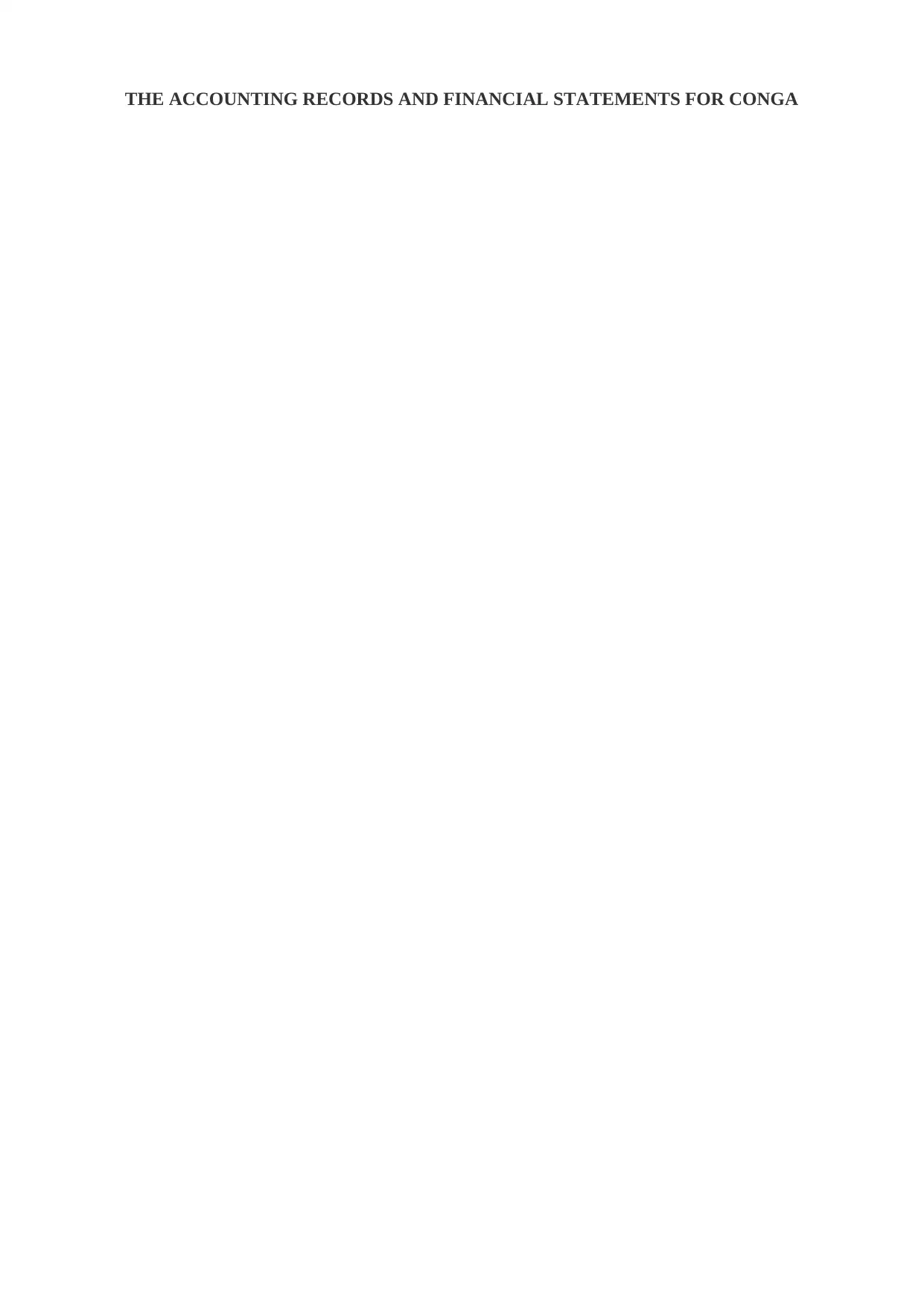
THE ACCOUNTING RECORDS AND FINANCIAL STATEMENTS FOR CONGA
Secure Best Marks with AI Grader
Need help grading? Try our AI Grader for instant feedback on your assignments.
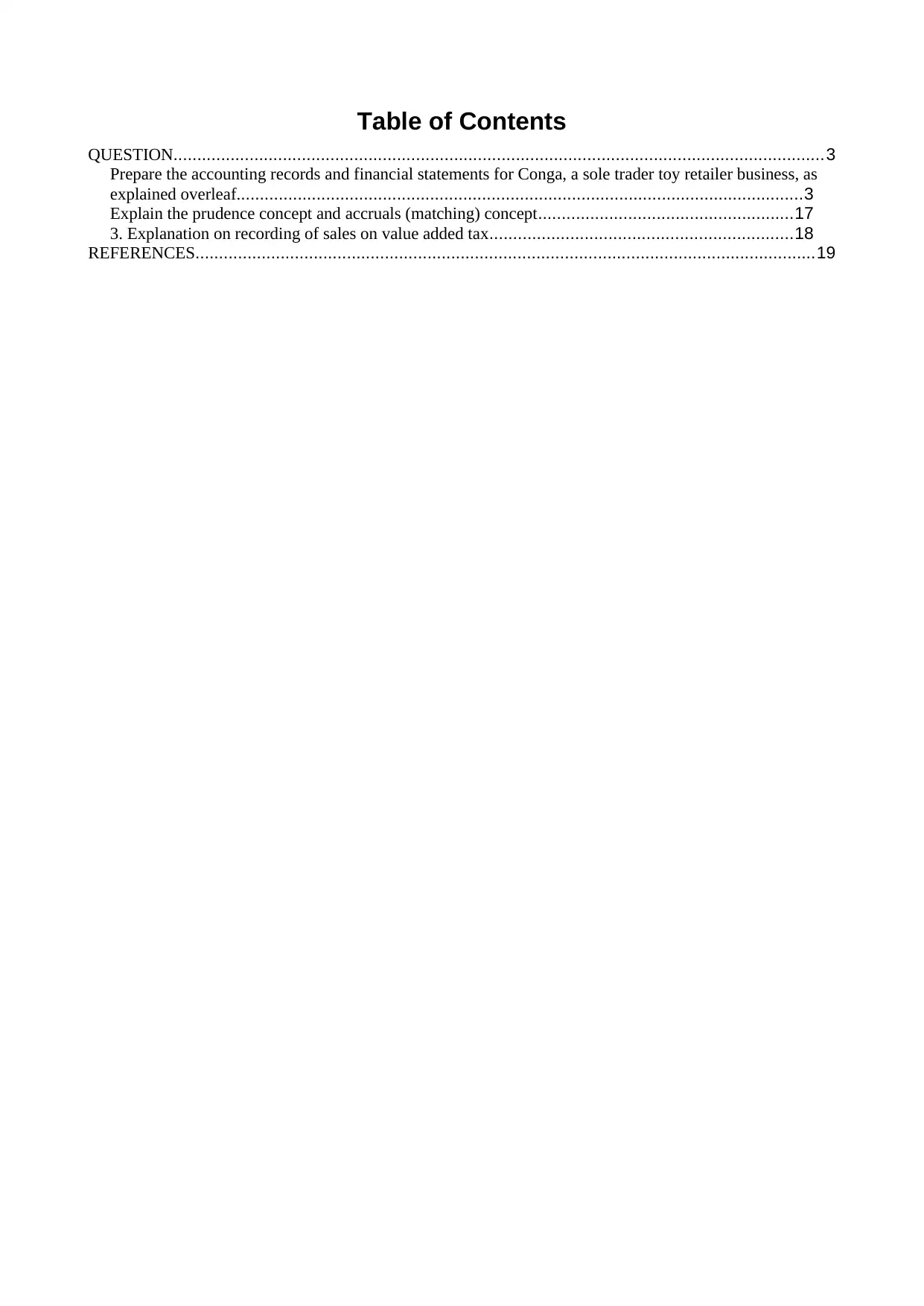
Table of Contents
QUESTION.........................................................................................................................................3
Prepare the accounting records and financial statements for Conga, a sole trader toy retailer business, as
explained overleaf........................................................................................................................3
Explain the prudence concept and accruals (matching) concept......................................................17
3. Explanation on recording of sales on value added tax................................................................18
REFERENCES...................................................................................................................................19
QUESTION.........................................................................................................................................3
Prepare the accounting records and financial statements for Conga, a sole trader toy retailer business, as
explained overleaf........................................................................................................................3
Explain the prudence concept and accruals (matching) concept......................................................17
3. Explanation on recording of sales on value added tax................................................................18
REFERENCES...................................................................................................................................19
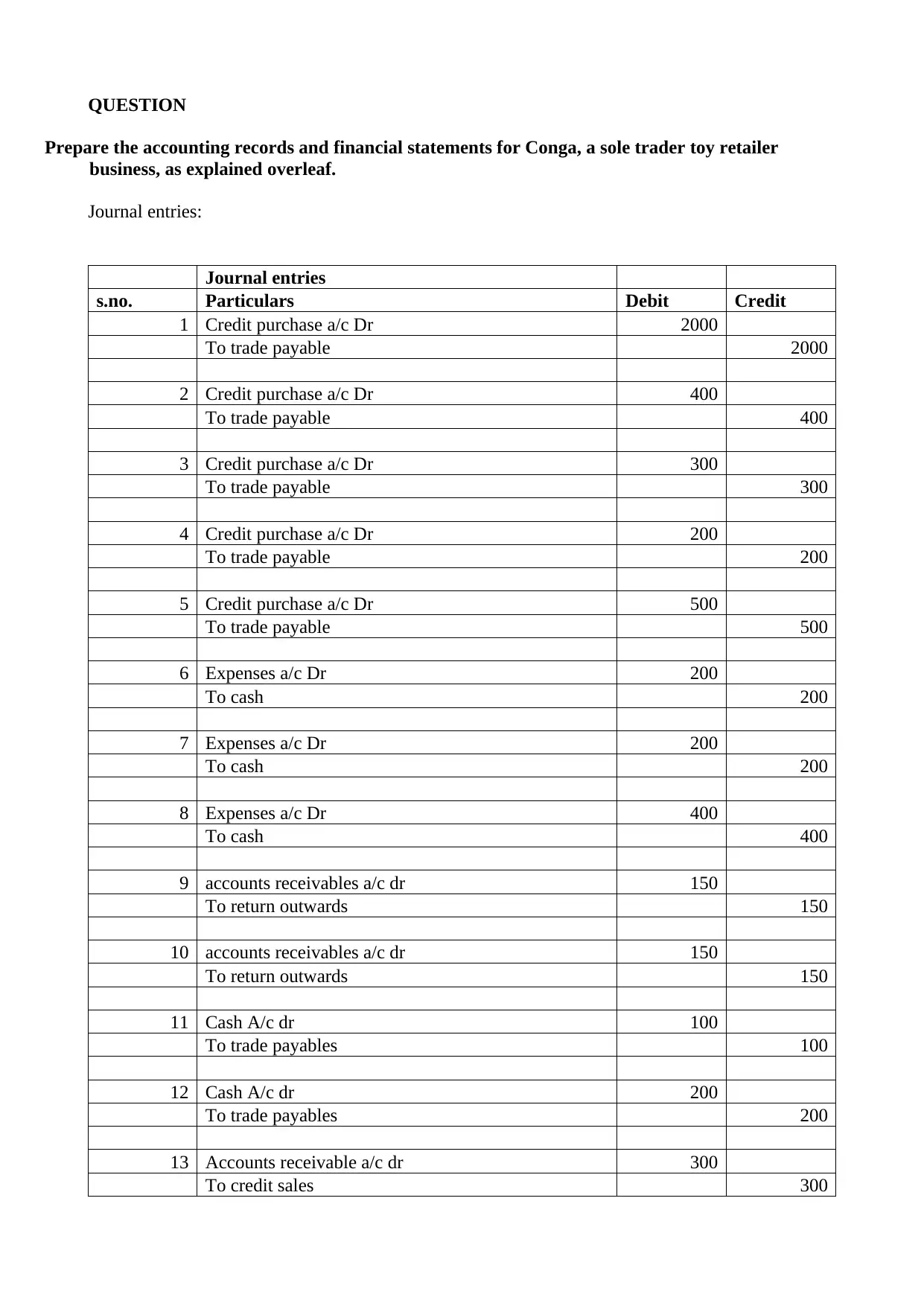
QUESTION
Prepare the accounting records and financial statements for Conga, a sole trader toy retailer
business, as explained overleaf.
Journal entries:
Journal entries
s.no. Particulars Debit Credit
1 Credit purchase a/c Dr 2000
To trade payable 2000
2 Credit purchase a/c Dr 400
To trade payable 400
3 Credit purchase a/c Dr 300
To trade payable 300
4 Credit purchase a/c Dr 200
To trade payable 200
5 Credit purchase a/c Dr 500
To trade payable 500
6 Expenses a/c Dr 200
To cash 200
7 Expenses a/c Dr 200
To cash 200
8 Expenses a/c Dr 400
To cash 400
9 accounts receivables a/c dr 150
To return outwards 150
10 accounts receivables a/c dr 150
To return outwards 150
11 Cash A/c dr 100
To trade payables 100
12 Cash A/c dr 200
To trade payables 200
13 Accounts receivable a/c dr 300
To credit sales 300
Prepare the accounting records and financial statements for Conga, a sole trader toy retailer
business, as explained overleaf.
Journal entries:
Journal entries
s.no. Particulars Debit Credit
1 Credit purchase a/c Dr 2000
To trade payable 2000
2 Credit purchase a/c Dr 400
To trade payable 400
3 Credit purchase a/c Dr 300
To trade payable 300
4 Credit purchase a/c Dr 200
To trade payable 200
5 Credit purchase a/c Dr 500
To trade payable 500
6 Expenses a/c Dr 200
To cash 200
7 Expenses a/c Dr 200
To cash 200
8 Expenses a/c Dr 400
To cash 400
9 accounts receivables a/c dr 150
To return outwards 150
10 accounts receivables a/c dr 150
To return outwards 150
11 Cash A/c dr 100
To trade payables 100
12 Cash A/c dr 200
To trade payables 200
13 Accounts receivable a/c dr 300
To credit sales 300
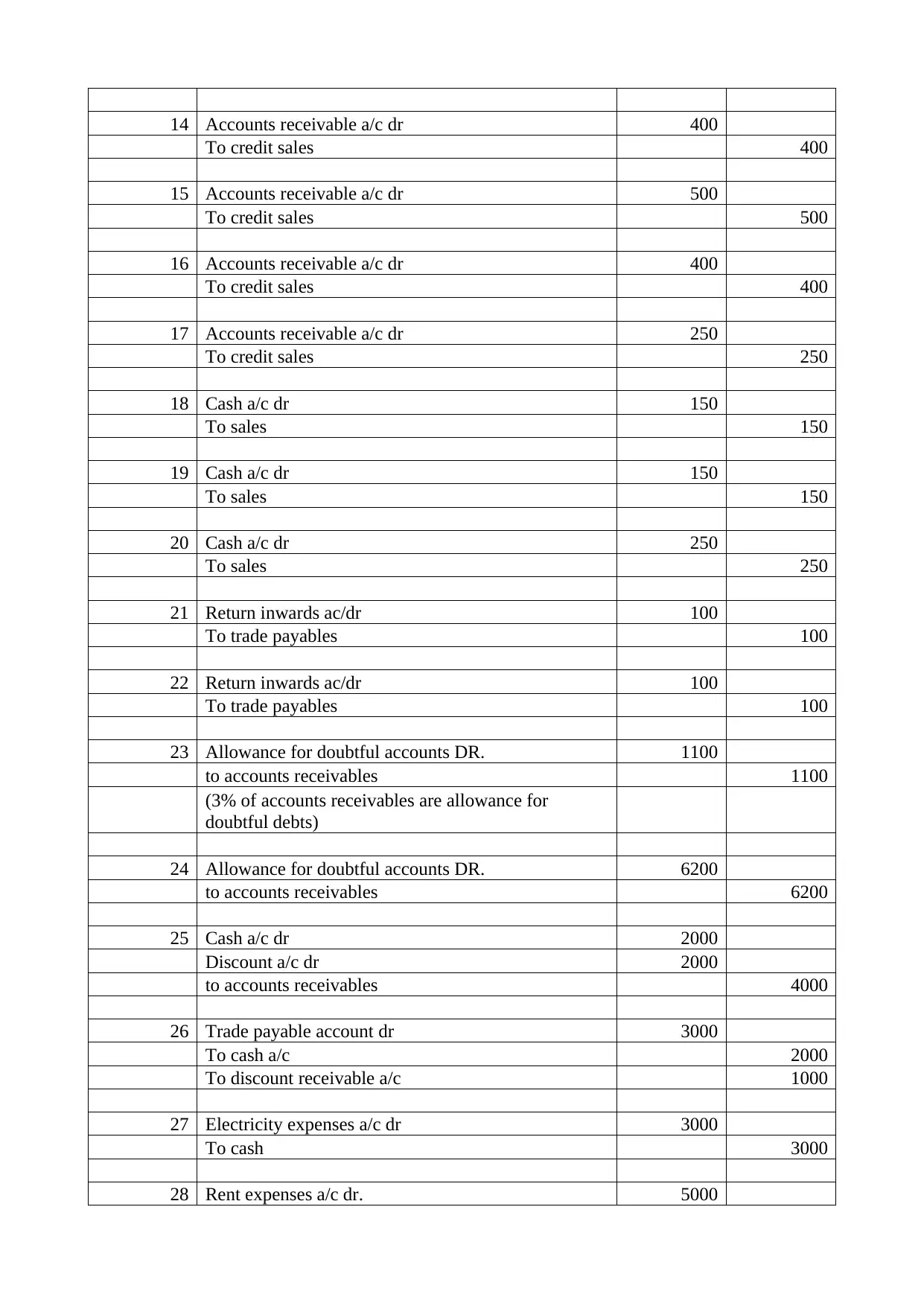
14 Accounts receivable a/c dr 400
To credit sales 400
15 Accounts receivable a/c dr 500
To credit sales 500
16 Accounts receivable a/c dr 400
To credit sales 400
17 Accounts receivable a/c dr 250
To credit sales 250
18 Cash a/c dr 150
To sales 150
19 Cash a/c dr 150
To sales 150
20 Cash a/c dr 250
To sales 250
21 Return inwards ac/dr 100
To trade payables 100
22 Return inwards ac/dr 100
To trade payables 100
23 Allowance for doubtful accounts DR. 1100
to accounts receivables 1100
(3% of accounts receivables are allowance for
doubtful debts)
24 Allowance for doubtful accounts DR. 6200
to accounts receivables 6200
25 Cash a/c dr 2000
Discount a/c dr 2000
to accounts receivables 4000
26 Trade payable account dr 3000
To cash a/c 2000
To discount receivable a/c 1000
27 Electricity expenses a/c dr 3000
To cash 3000
28 Rent expenses a/c dr. 5000
To credit sales 400
15 Accounts receivable a/c dr 500
To credit sales 500
16 Accounts receivable a/c dr 400
To credit sales 400
17 Accounts receivable a/c dr 250
To credit sales 250
18 Cash a/c dr 150
To sales 150
19 Cash a/c dr 150
To sales 150
20 Cash a/c dr 250
To sales 250
21 Return inwards ac/dr 100
To trade payables 100
22 Return inwards ac/dr 100
To trade payables 100
23 Allowance for doubtful accounts DR. 1100
to accounts receivables 1100
(3% of accounts receivables are allowance for
doubtful debts)
24 Allowance for doubtful accounts DR. 6200
to accounts receivables 6200
25 Cash a/c dr 2000
Discount a/c dr 2000
to accounts receivables 4000
26 Trade payable account dr 3000
To cash a/c 2000
To discount receivable a/c 1000
27 Electricity expenses a/c dr 3000
To cash 3000
28 Rent expenses a/c dr. 5000
Secure Best Marks with AI Grader
Need help grading? Try our AI Grader for instant feedback on your assignments.
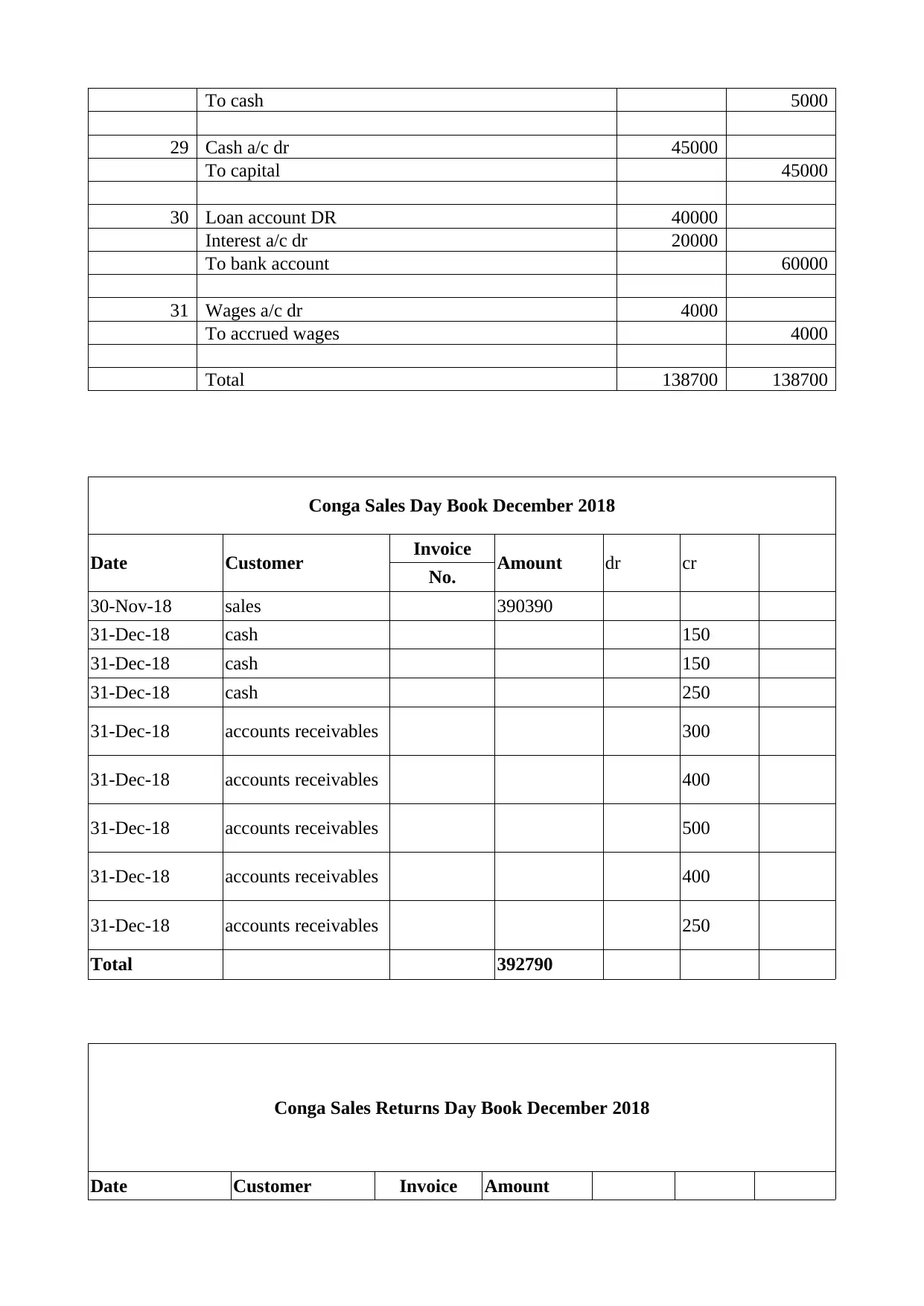
To cash 5000
29 Cash a/c dr 45000
To capital 45000
30 Loan account DR 40000
Interest a/c dr 20000
To bank account 60000
31 Wages a/c dr 4000
To accrued wages 4000
Total 138700 138700
Conga Sales Day Book December 2018
Date Customer Invoice Amount dr cr
No.
30-Nov-18 sales 390390
31-Dec-18 cash 150
31-Dec-18 cash 150
31-Dec-18 cash 250
31-Dec-18 accounts receivables 300
31-Dec-18 accounts receivables 400
31-Dec-18 accounts receivables 500
31-Dec-18 accounts receivables 400
31-Dec-18 accounts receivables 250
Total 392790
Conga Sales Returns Day Book December 2018
Date Customer Invoice Amount
29 Cash a/c dr 45000
To capital 45000
30 Loan account DR 40000
Interest a/c dr 20000
To bank account 60000
31 Wages a/c dr 4000
To accrued wages 4000
Total 138700 138700
Conga Sales Day Book December 2018
Date Customer Invoice Amount dr cr
No.
30-Nov-18 sales 390390
31-Dec-18 cash 150
31-Dec-18 cash 150
31-Dec-18 cash 250
31-Dec-18 accounts receivables 300
31-Dec-18 accounts receivables 400
31-Dec-18 accounts receivables 500
31-Dec-18 accounts receivables 400
31-Dec-18 accounts receivables 250
Total 392790
Conga Sales Returns Day Book December 2018
Date Customer Invoice Amount
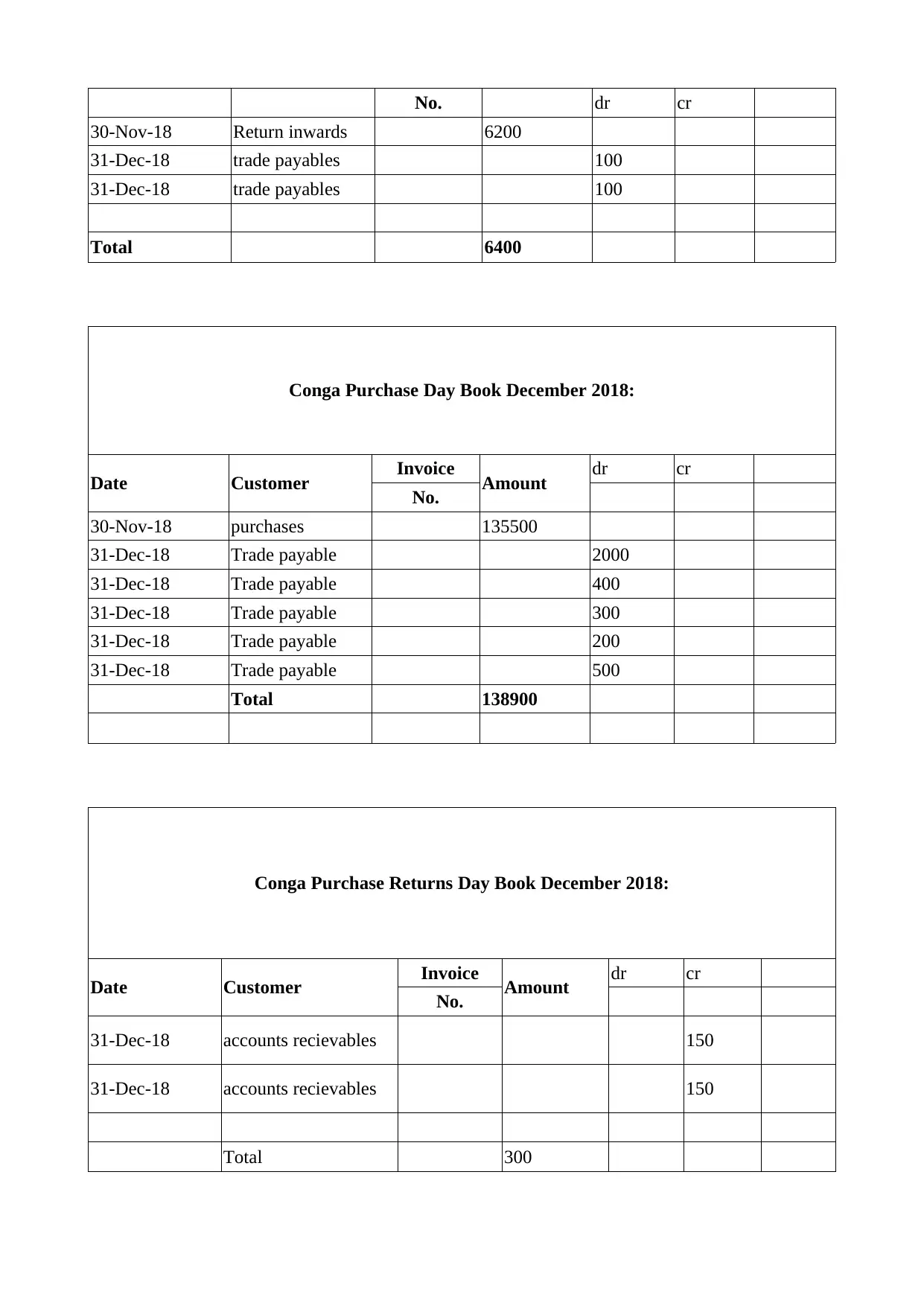
No. dr cr
30-Nov-18 Return inwards 6200
31-Dec-18 trade payables 100
31-Dec-18 trade payables 100
Total 6400
Conga Purchase Day Book December 2018:
Date Customer Invoice Amount dr cr
No.
30-Nov-18 purchases 135500
31-Dec-18 Trade payable 2000
31-Dec-18 Trade payable 400
31-Dec-18 Trade payable 300
31-Dec-18 Trade payable 200
31-Dec-18 Trade payable 500
Total 138900
Conga Purchase Returns Day Book December 2018:
Date Customer Invoice Amount dr cr
No.
31-Dec-18 accounts recievables 150
31-Dec-18 accounts recievables 150
Total 300
30-Nov-18 Return inwards 6200
31-Dec-18 trade payables 100
31-Dec-18 trade payables 100
Total 6400
Conga Purchase Day Book December 2018:
Date Customer Invoice Amount dr cr
No.
30-Nov-18 purchases 135500
31-Dec-18 Trade payable 2000
31-Dec-18 Trade payable 400
31-Dec-18 Trade payable 300
31-Dec-18 Trade payable 200
31-Dec-18 Trade payable 500
Total 138900
Conga Purchase Returns Day Book December 2018:
Date Customer Invoice Amount dr cr
No.
31-Dec-18 accounts recievables 150
31-Dec-18 accounts recievables 150
Total 300
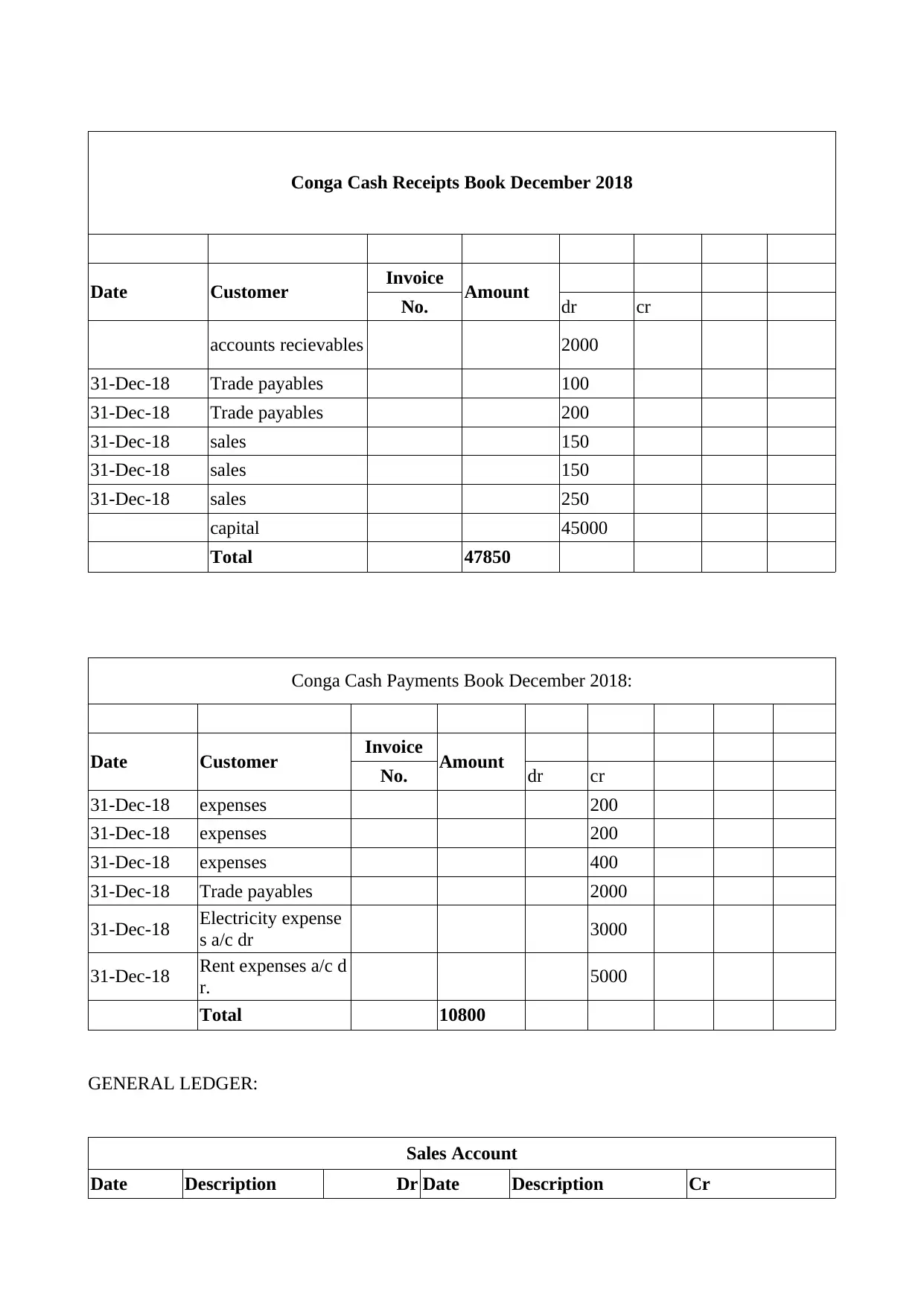
Conga Cash Receipts Book December 2018
Date Customer Invoice Amount
No. dr cr
accounts recievables 2000
31-Dec-18 Trade payables 100
31-Dec-18 Trade payables 200
31-Dec-18 sales 150
31-Dec-18 sales 150
31-Dec-18 sales 250
capital 45000
Total 47850
Conga Cash Payments Book December 2018:
Date Customer Invoice Amount
No. dr cr
31-Dec-18 expenses 200
31-Dec-18 expenses 200
31-Dec-18 expenses 400
31-Dec-18 Trade payables 2000
31-Dec-18 Electricity expense
s a/c dr 3000
31-Dec-18 Rent expenses a/c d
r. 5000
Total 10800
GENERAL LEDGER:
Sales Account
Date Description Dr Date Description Cr
Date Customer Invoice Amount
No. dr cr
accounts recievables 2000
31-Dec-18 Trade payables 100
31-Dec-18 Trade payables 200
31-Dec-18 sales 150
31-Dec-18 sales 150
31-Dec-18 sales 250
capital 45000
Total 47850
Conga Cash Payments Book December 2018:
Date Customer Invoice Amount
No. dr cr
31-Dec-18 expenses 200
31-Dec-18 expenses 200
31-Dec-18 expenses 400
31-Dec-18 Trade payables 2000
31-Dec-18 Electricity expense
s a/c dr 3000
31-Dec-18 Rent expenses a/c d
r. 5000
Total 10800
GENERAL LEDGER:
Sales Account
Date Description Dr Date Description Cr
Paraphrase This Document
Need a fresh take? Get an instant paraphrase of this document with our AI Paraphraser
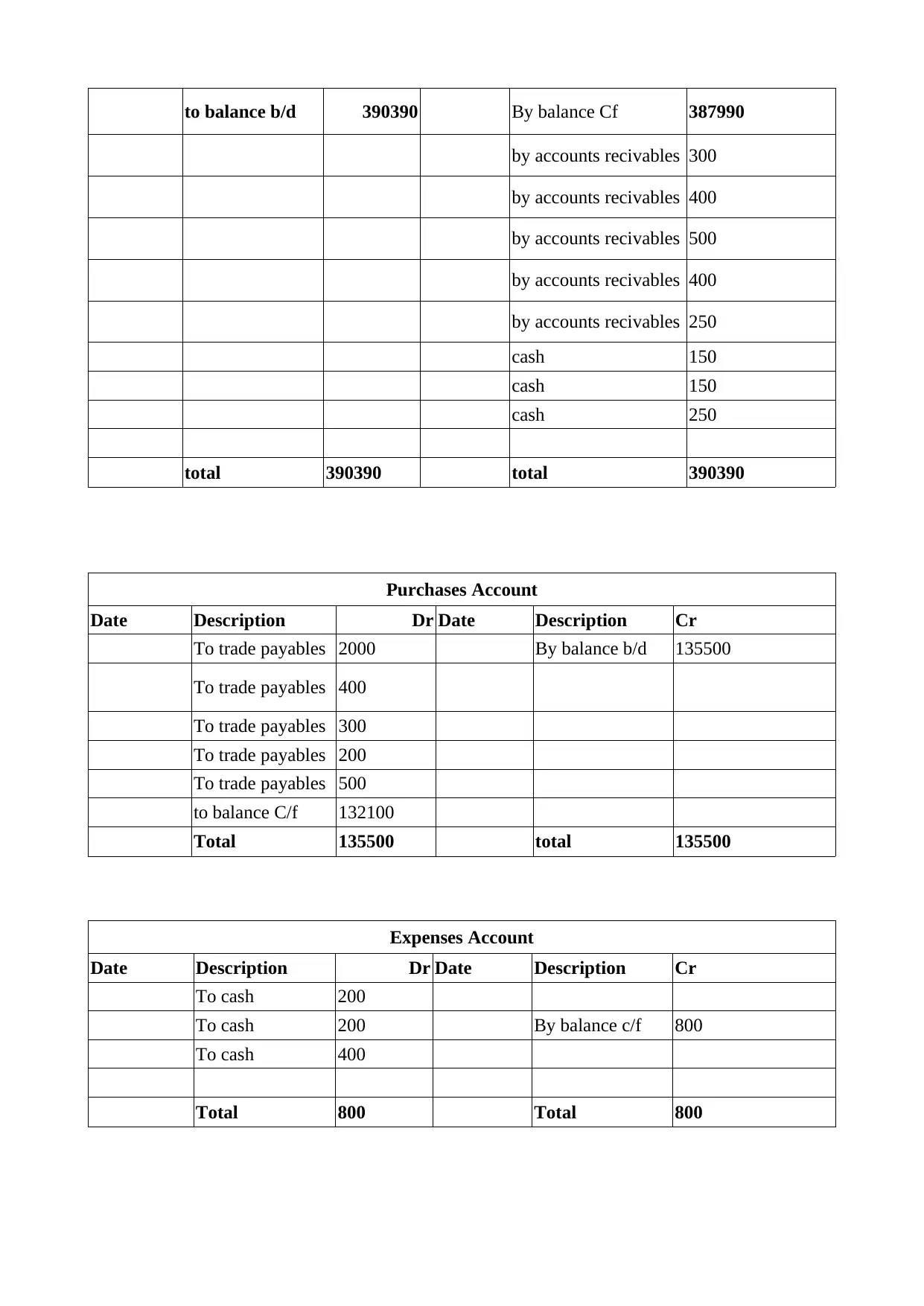
to balance b/d 390390 By balance Cf 387990
by accounts recivables 300
by accounts recivables 400
by accounts recivables 500
by accounts recivables 400
by accounts recivables 250
cash 150
cash 150
cash 250
total 390390 total 390390
Purchases Account
Date Description Dr Date Description Cr
To trade payables 2000 By balance b/d 135500
To trade payables 400
To trade payables 300
To trade payables 200
To trade payables 500
to balance C/f 132100
Total 135500 total 135500
Expenses Account
Date Description Dr Date Description Cr
To cash 200
To cash 200 By balance c/f 800
To cash 400
Total 800 Total 800
by accounts recivables 300
by accounts recivables 400
by accounts recivables 500
by accounts recivables 400
by accounts recivables 250
cash 150
cash 150
cash 250
total 390390 total 390390
Purchases Account
Date Description Dr Date Description Cr
To trade payables 2000 By balance b/d 135500
To trade payables 400
To trade payables 300
To trade payables 200
To trade payables 500
to balance C/f 132100
Total 135500 total 135500
Expenses Account
Date Description Dr Date Description Cr
To cash 200
To cash 200 By balance c/f 800
To cash 400
Total 800 Total 800
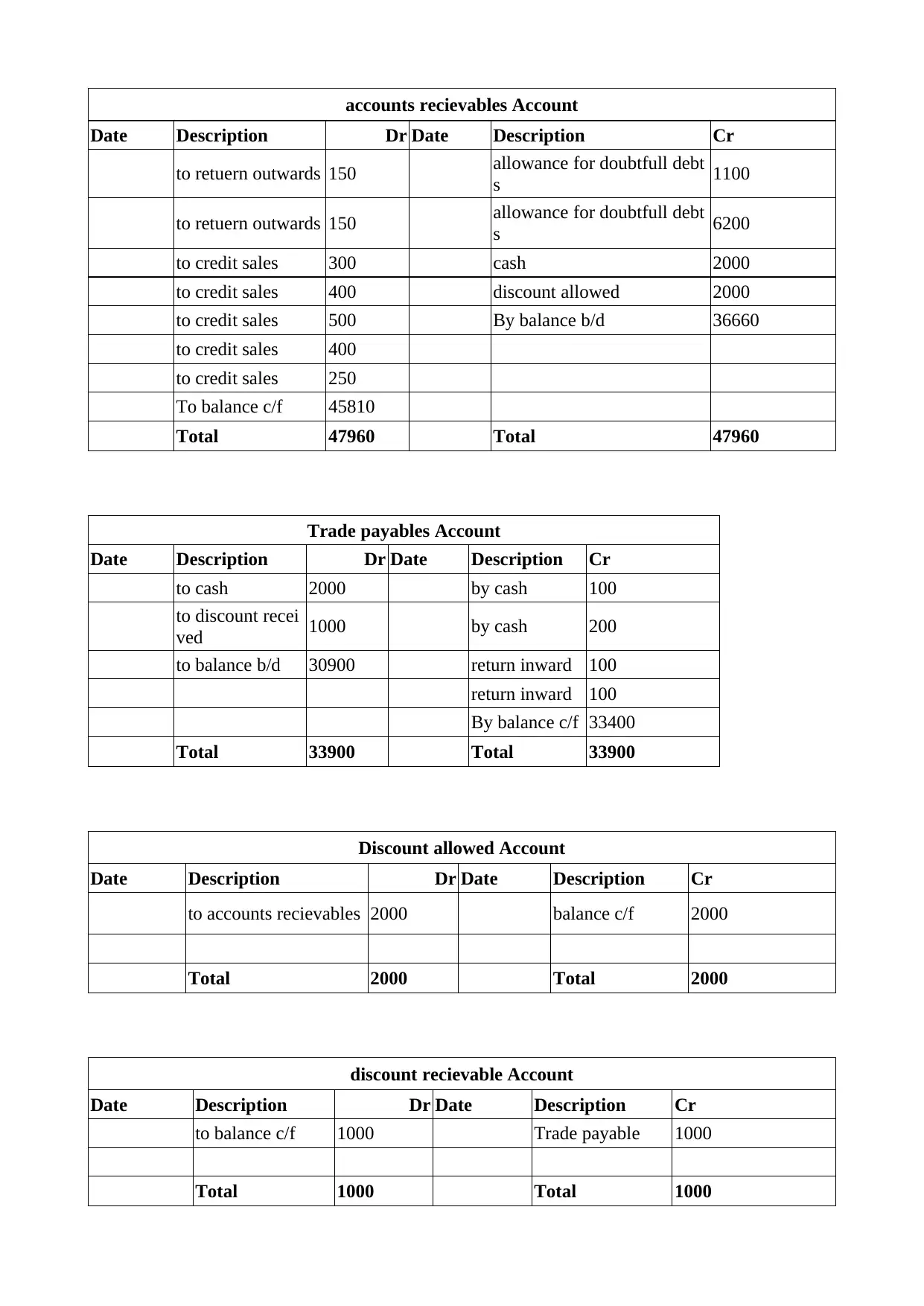
accounts recievables Account
Date Description Dr Date Description Cr
to retuern outwards 150 allowance for doubtfull debt
s 1100
to retuern outwards 150 allowance for doubtfull debt
s 6200
to credit sales 300 cash 2000
to credit sales 400 discount allowed 2000
to credit sales 500 By balance b/d 36660
to credit sales 400
to credit sales 250
To balance c/f 45810
Total 47960 Total 47960
Trade payables Account
Date Description Dr Date Description Cr
to cash 2000 by cash 100
to discount recei
ved 1000 by cash 200
to balance b/d 30900 return inward 100
return inward 100
By balance c/f 33400
Total 33900 Total 33900
Discount allowed Account
Date Description Dr Date Description Cr
to accounts recievables 2000 balance c/f 2000
Total 2000 Total 2000
discount recievable Account
Date Description Dr Date Description Cr
to balance c/f 1000 Trade payable 1000
Total 1000 Total 1000
Date Description Dr Date Description Cr
to retuern outwards 150 allowance for doubtfull debt
s 1100
to retuern outwards 150 allowance for doubtfull debt
s 6200
to credit sales 300 cash 2000
to credit sales 400 discount allowed 2000
to credit sales 500 By balance b/d 36660
to credit sales 400
to credit sales 250
To balance c/f 45810
Total 47960 Total 47960
Trade payables Account
Date Description Dr Date Description Cr
to cash 2000 by cash 100
to discount recei
ved 1000 by cash 200
to balance b/d 30900 return inward 100
return inward 100
By balance c/f 33400
Total 33900 Total 33900
Discount allowed Account
Date Description Dr Date Description Cr
to accounts recievables 2000 balance c/f 2000
Total 2000 Total 2000
discount recievable Account
Date Description Dr Date Description Cr
to balance c/f 1000 Trade payable 1000
Total 1000 Total 1000
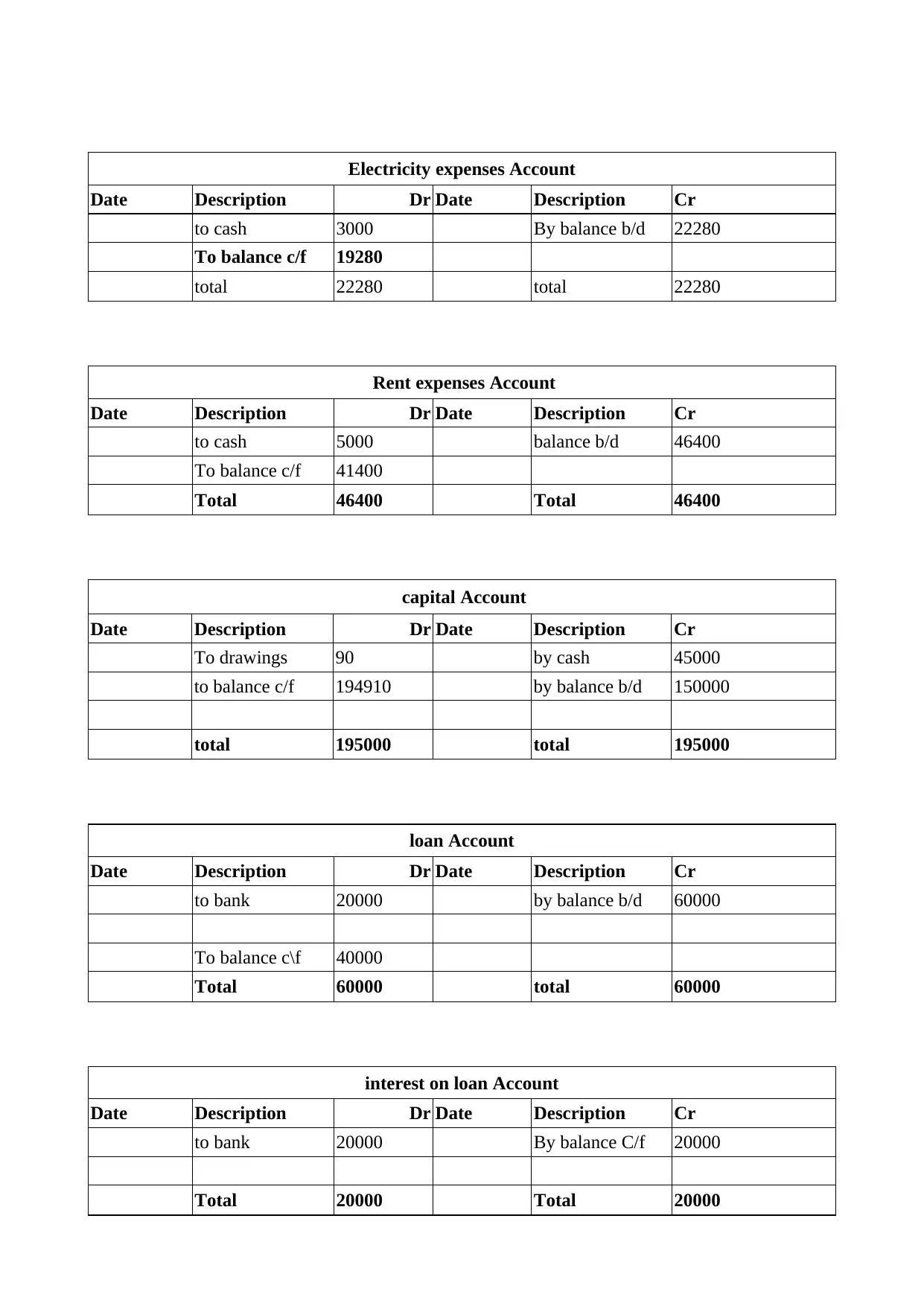
Electricity expenses Account
Date Description Dr Date Description Cr
to cash 3000 By balance b/d 22280
To balance c/f 19280
total 22280 total 22280
Rent expenses Account
Date Description Dr Date Description Cr
to cash 5000 balance b/d 46400
To balance c/f 41400
Total 46400 Total 46400
capital Account
Date Description Dr Date Description Cr
To drawings 90 by cash 45000
to balance c/f 194910 by balance b/d 150000
total 195000 total 195000
loan Account
Date Description Dr Date Description Cr
to bank 20000 by balance b/d 60000
To balance c\f 40000
Total 60000 total 60000
interest on loan Account
Date Description Dr Date Description Cr
to bank 20000 By balance C/f 20000
Total 20000 Total 20000
Date Description Dr Date Description Cr
to cash 3000 By balance b/d 22280
To balance c/f 19280
total 22280 total 22280
Rent expenses Account
Date Description Dr Date Description Cr
to cash 5000 balance b/d 46400
To balance c/f 41400
Total 46400 Total 46400
capital Account
Date Description Dr Date Description Cr
To drawings 90 by cash 45000
to balance c/f 194910 by balance b/d 150000
total 195000 total 195000
loan Account
Date Description Dr Date Description Cr
to bank 20000 by balance b/d 60000
To balance c\f 40000
Total 60000 total 60000
interest on loan Account
Date Description Dr Date Description Cr
to bank 20000 By balance C/f 20000
Total 20000 Total 20000
Secure Best Marks with AI Grader
Need help grading? Try our AI Grader for instant feedback on your assignments.
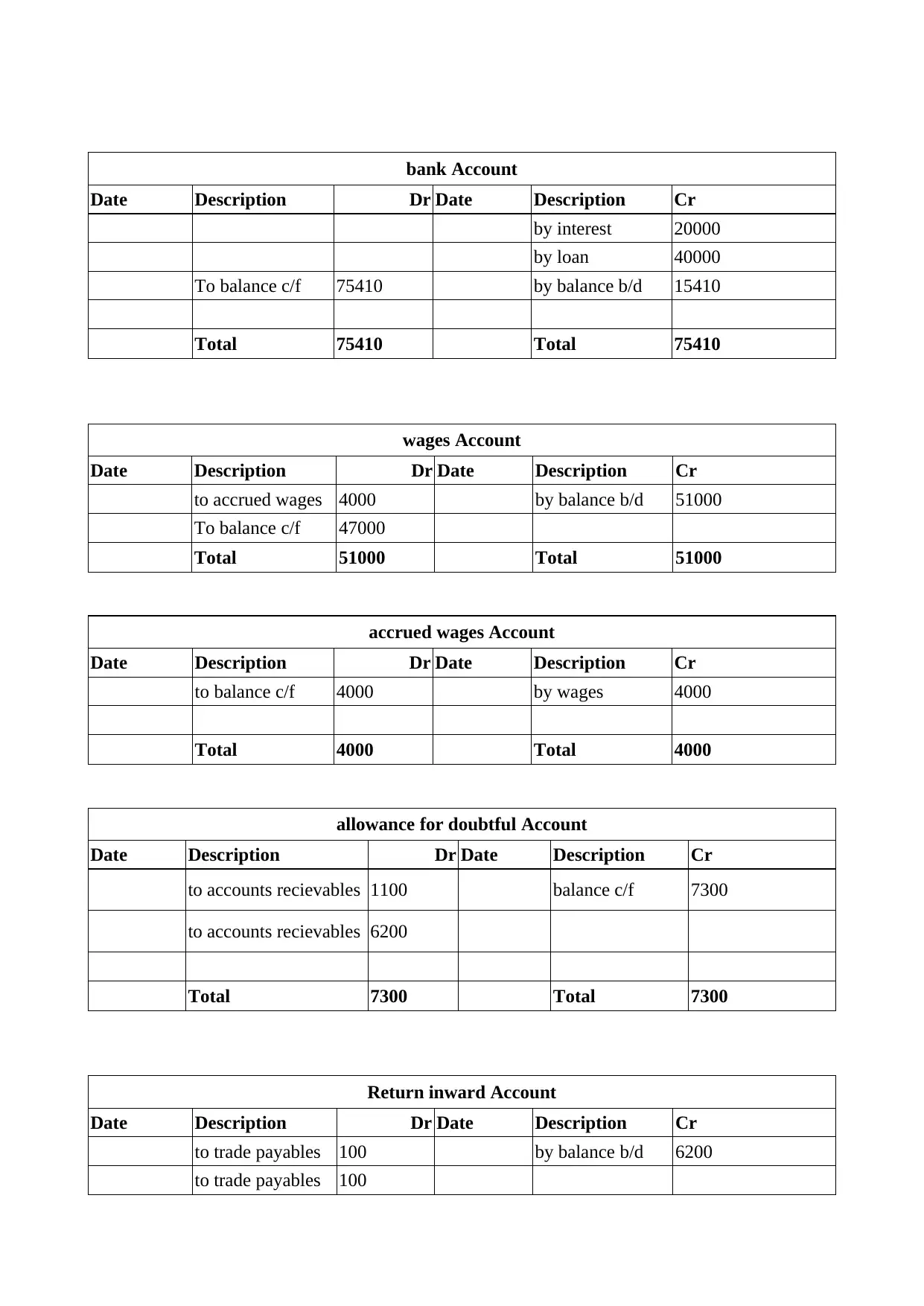
bank Account
Date Description Dr Date Description Cr
by interest 20000
by loan 40000
To balance c/f 75410 by balance b/d 15410
Total 75410 Total 75410
wages Account
Date Description Dr Date Description Cr
to accrued wages 4000 by balance b/d 51000
To balance c/f 47000
Total 51000 Total 51000
accrued wages Account
Date Description Dr Date Description Cr
to balance c/f 4000 by wages 4000
Total 4000 Total 4000
allowance for doubtful Account
Date Description Dr Date Description Cr
to accounts recievables 1100 balance c/f 7300
to accounts recievables 6200
Total 7300 Total 7300
Return inward Account
Date Description Dr Date Description Cr
to trade payables 100 by balance b/d 6200
to trade payables 100
Date Description Dr Date Description Cr
by interest 20000
by loan 40000
To balance c/f 75410 by balance b/d 15410
Total 75410 Total 75410
wages Account
Date Description Dr Date Description Cr
to accrued wages 4000 by balance b/d 51000
To balance c/f 47000
Total 51000 Total 51000
accrued wages Account
Date Description Dr Date Description Cr
to balance c/f 4000 by wages 4000
Total 4000 Total 4000
allowance for doubtful Account
Date Description Dr Date Description Cr
to accounts recievables 1100 balance c/f 7300
to accounts recievables 6200
Total 7300 Total 7300
Return inward Account
Date Description Dr Date Description Cr
to trade payables 100 by balance b/d 6200
to trade payables 100
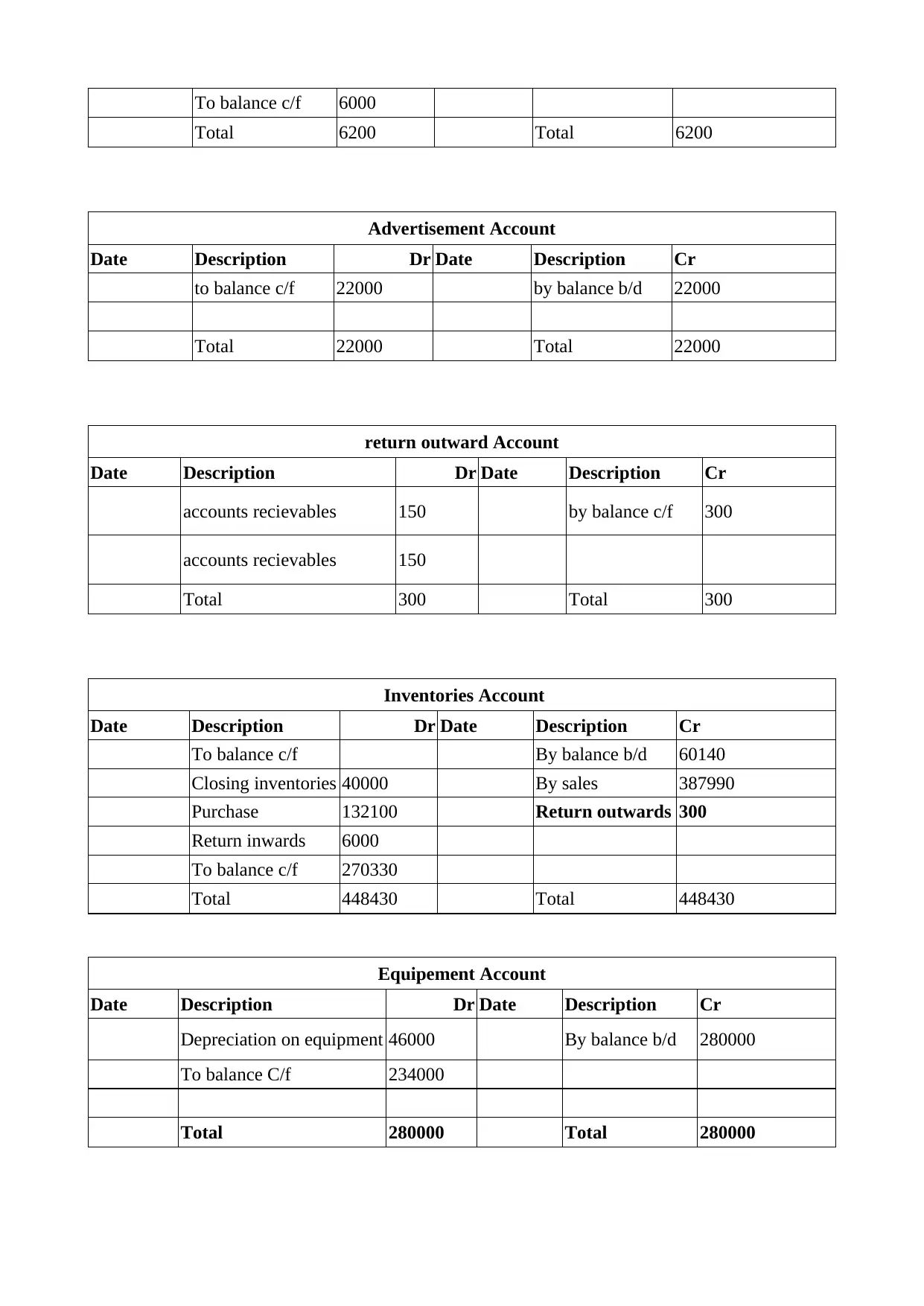
To balance c/f 6000
Total 6200 Total 6200
Advertisement Account
Date Description Dr Date Description Cr
to balance c/f 22000 by balance b/d 22000
Total 22000 Total 22000
return outward Account
Date Description Dr Date Description Cr
accounts recievables 150 by balance c/f 300
accounts recievables 150
Total 300 Total 300
Inventories Account
Date Description Dr Date Description Cr
To balance c/f By balance b/d 60140
Closing inventories 40000 By sales 387990
Purchase 132100 Return outwards 300
Return inwards 6000
To balance c/f 270330
Total 448430 Total 448430
Equipement Account
Date Description Dr Date Description Cr
Depreciation on equipment 46000 By balance b/d 280000
To balance C/f 234000
Total 280000 Total 280000
Total 6200 Total 6200
Advertisement Account
Date Description Dr Date Description Cr
to balance c/f 22000 by balance b/d 22000
Total 22000 Total 22000
return outward Account
Date Description Dr Date Description Cr
accounts recievables 150 by balance c/f 300
accounts recievables 150
Total 300 Total 300
Inventories Account
Date Description Dr Date Description Cr
To balance c/f By balance b/d 60140
Closing inventories 40000 By sales 387990
Purchase 132100 Return outwards 300
Return inwards 6000
To balance c/f 270330
Total 448430 Total 448430
Equipement Account
Date Description Dr Date Description Cr
Depreciation on equipment 46000 By balance b/d 280000
To balance C/f 234000
Total 280000 Total 280000
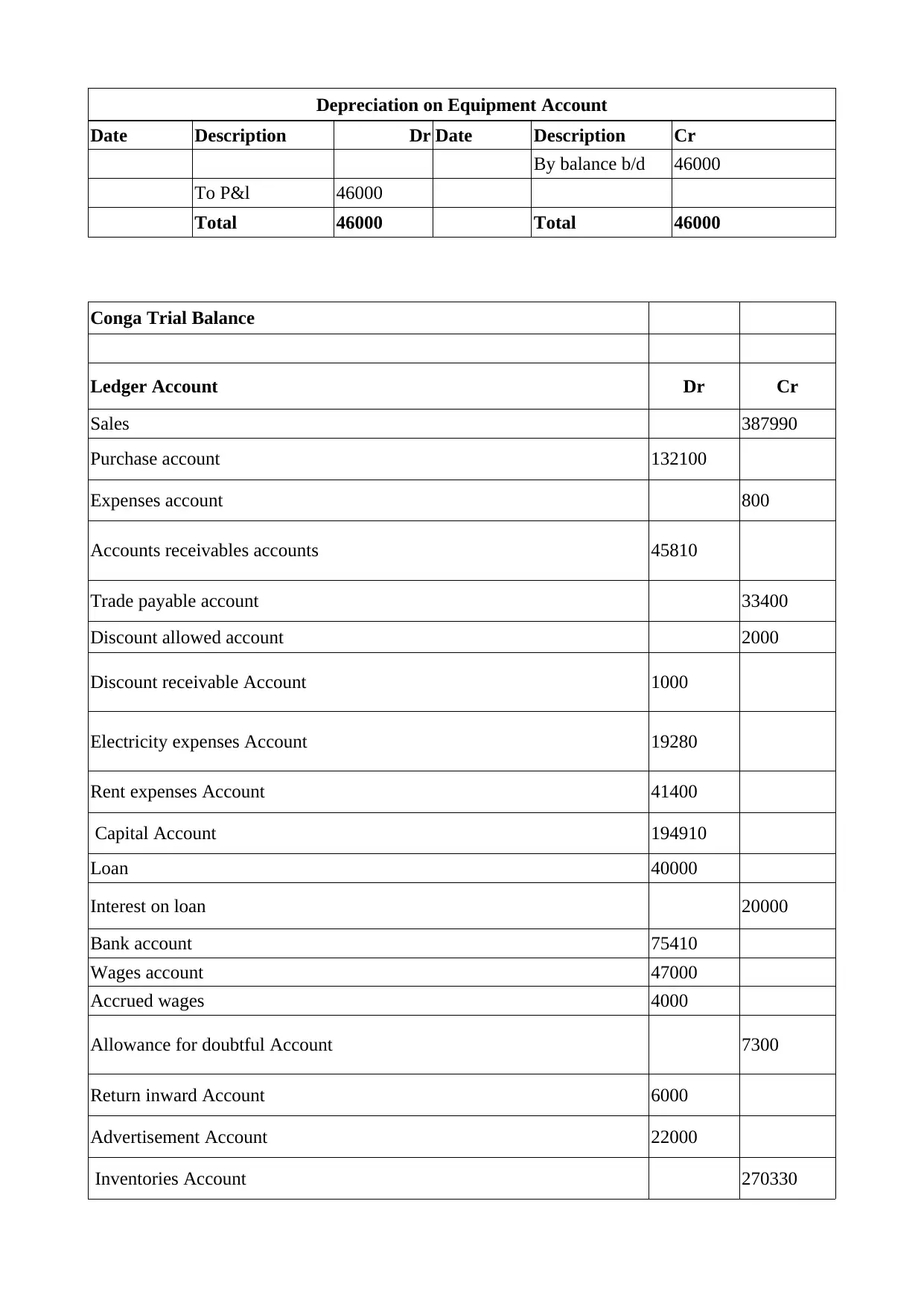
Depreciation on Equipment Account
Date Description Dr Date Description Cr
By balance b/d 46000
To P&l 46000
Total 46000 Total 46000
Conga Trial Balance
Ledger Account Dr Cr
Sales 387990
Purchase account 132100
Expenses account 800
Accounts receivables accounts 45810
Trade payable account 33400
Discount allowed account 2000
Discount receivable Account 1000
Electricity expenses Account 19280
Rent expenses Account 41400
Capital Account 194910
Loan 40000
Interest on loan 20000
Bank account 75410
Wages account 47000
Accrued wages 4000
Allowance for doubtful Account 7300
Return inward Account 6000
Advertisement Account 22000
Inventories Account 270330
Date Description Dr Date Description Cr
By balance b/d 46000
To P&l 46000
Total 46000 Total 46000
Conga Trial Balance
Ledger Account Dr Cr
Sales 387990
Purchase account 132100
Expenses account 800
Accounts receivables accounts 45810
Trade payable account 33400
Discount allowed account 2000
Discount receivable Account 1000
Electricity expenses Account 19280
Rent expenses Account 41400
Capital Account 194910
Loan 40000
Interest on loan 20000
Bank account 75410
Wages account 47000
Accrued wages 4000
Allowance for doubtful Account 7300
Return inward Account 6000
Advertisement Account 22000
Inventories Account 270330
Paraphrase This Document
Need a fresh take? Get an instant paraphrase of this document with our AI Paraphraser
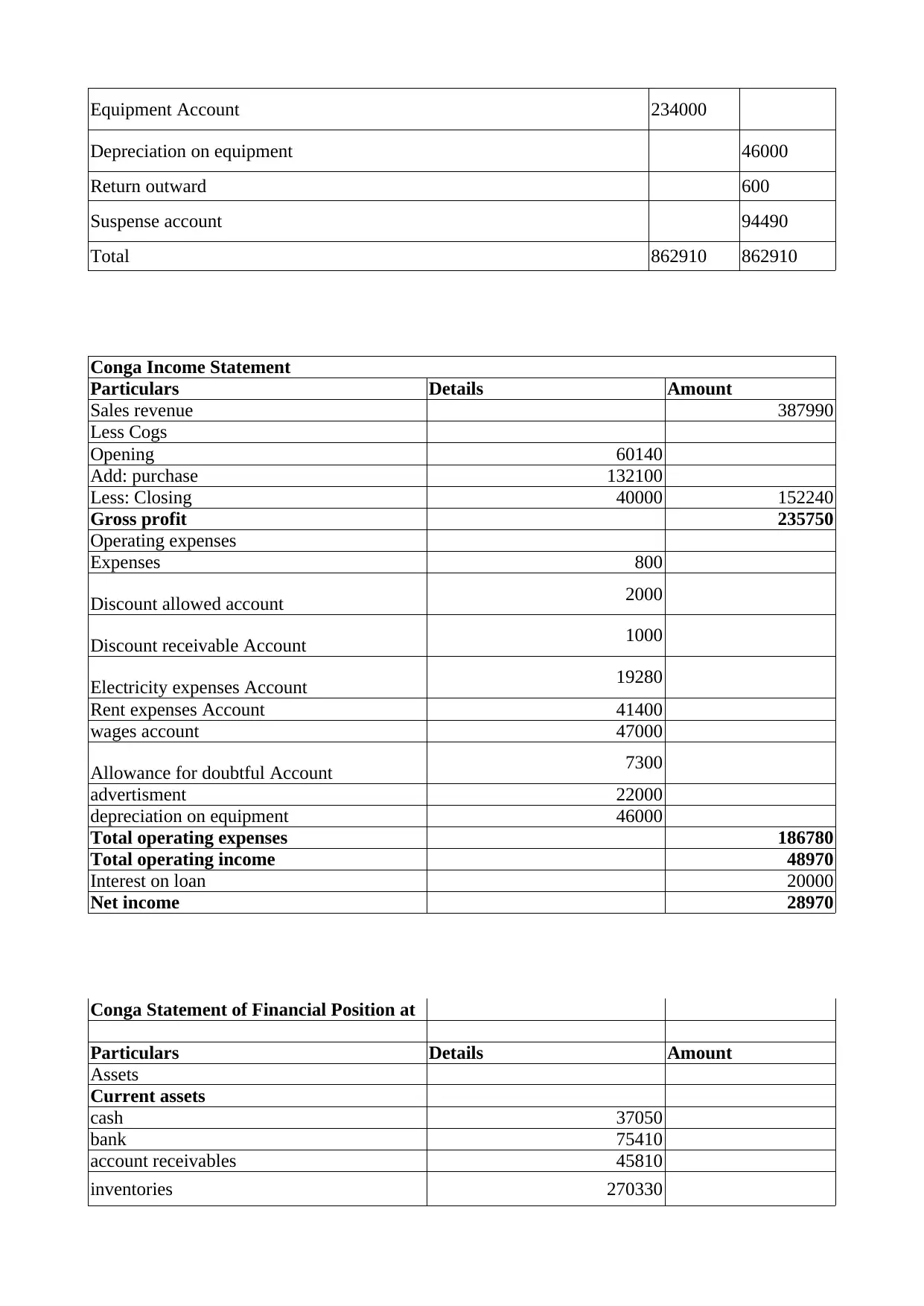
Equipment Account 234000
Depreciation on equipment 46000
Return outward 600
Suspense account 94490
Total 862910 862910
Conga Income Statement
Particulars Details Amount
Sales revenue 387990
Less Cogs
Opening 60140
Add: purchase 132100
Less: Closing 40000 152240
Gross profit 235750
Operating expenses
Expenses 800
Discount allowed account 2000
Discount receivable Account 1000
Electricity expenses Account 19280
Rent expenses Account 41400
wages account 47000
Allowance for doubtful Account 7300
advertisment 22000
depreciation on equipment 46000
Total operating expenses 186780
Total operating income 48970
Interest on loan 20000
Net income 28970
Conga Statement of Financial Position at
Particulars Details Amount
Assets
Current assets
cash 37050
bank 75410
account receivables 45810
inventories 270330
Depreciation on equipment 46000
Return outward 600
Suspense account 94490
Total 862910 862910
Conga Income Statement
Particulars Details Amount
Sales revenue 387990
Less Cogs
Opening 60140
Add: purchase 132100
Less: Closing 40000 152240
Gross profit 235750
Operating expenses
Expenses 800
Discount allowed account 2000
Discount receivable Account 1000
Electricity expenses Account 19280
Rent expenses Account 41400
wages account 47000
Allowance for doubtful Account 7300
advertisment 22000
depreciation on equipment 46000
Total operating expenses 186780
Total operating income 48970
Interest on loan 20000
Net income 28970
Conga Statement of Financial Position at
Particulars Details Amount
Assets
Current assets
cash 37050
bank 75410
account receivables 45810
inventories 270330
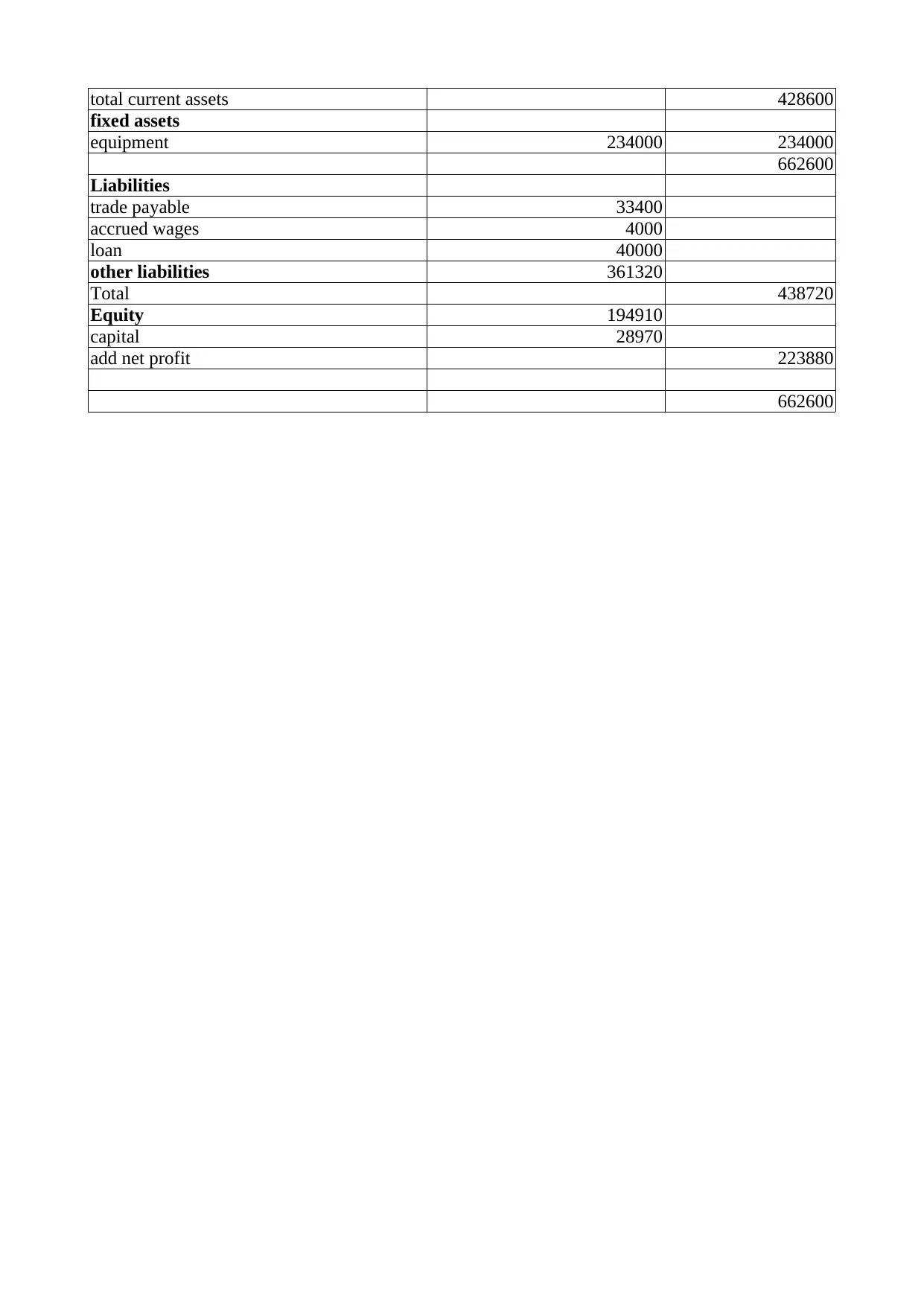
total current assets 428600
fixed assets
equipment 234000 234000
662600
Liabilities
trade payable 33400
accrued wages 4000
loan 40000
other liabilities 361320
Total 438720
Equity 194910
capital 28970
add net profit 223880
662600
fixed assets
equipment 234000 234000
662600
Liabilities
trade payable 33400
accrued wages 4000
loan 40000
other liabilities 361320
Total 438720
Equity 194910
capital 28970
add net profit 223880
662600
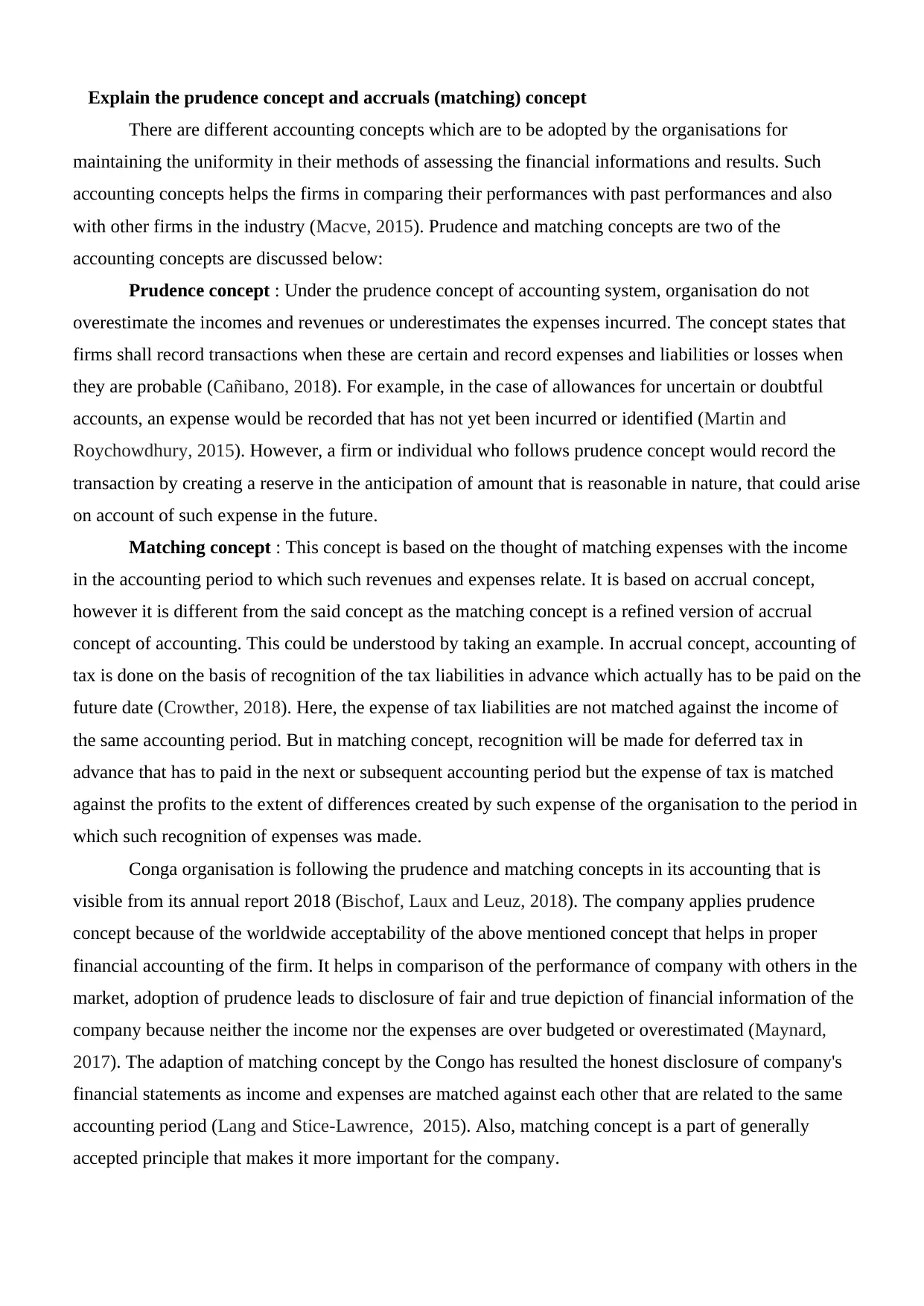
Explain the prudence concept and accruals (matching) concept
There are different accounting concepts which are to be adopted by the organisations for
maintaining the uniformity in their methods of assessing the financial informations and results. Such
accounting concepts helps the firms in comparing their performances with past performances and also
with other firms in the industry (Macve, 2015). Prudence and matching concepts are two of the
accounting concepts are discussed below:
Prudence concept : Under the prudence concept of accounting system, organisation do not
overestimate the incomes and revenues or underestimates the expenses incurred. The concept states that
firms shall record transactions when these are certain and record expenses and liabilities or losses when
they are probable (Cañibano, 2018). For example, in the case of allowances for uncertain or doubtful
accounts, an expense would be recorded that has not yet been incurred or identified (Martin and
Roychowdhury, 2015). However, a firm or individual who follows prudence concept would record the
transaction by creating a reserve in the anticipation of amount that is reasonable in nature, that could arise
on account of such expense in the future.
Matching concept : This concept is based on the thought of matching expenses with the income
in the accounting period to which such revenues and expenses relate. It is based on accrual concept,
however it is different from the said concept as the matching concept is a refined version of accrual
concept of accounting. This could be understood by taking an example. In accrual concept, accounting of
tax is done on the basis of recognition of the tax liabilities in advance which actually has to be paid on the
future date (Crowther, 2018). Here, the expense of tax liabilities are not matched against the income of
the same accounting period. But in matching concept, recognition will be made for deferred tax in
advance that has to paid in the next or subsequent accounting period but the expense of tax is matched
against the profits to the extent of differences created by such expense of the organisation to the period in
which such recognition of expenses was made.
Conga organisation is following the prudence and matching concepts in its accounting that is
visible from its annual report 2018 (Bischof, Laux and Leuz, 2018). The company applies prudence
concept because of the worldwide acceptability of the above mentioned concept that helps in proper
financial accounting of the firm. It helps in comparison of the performance of company with others in the
market, adoption of prudence leads to disclosure of fair and true depiction of financial information of the
company because neither the income nor the expenses are over budgeted or overestimated (Maynard,
2017). The adaption of matching concept by the Congo has resulted the honest disclosure of company's
financial statements as income and expenses are matched against each other that are related to the same
accounting period (Lang and Stice-Lawrence, 2015). Also, matching concept is a part of generally
accepted principle that makes it more important for the company.
There are different accounting concepts which are to be adopted by the organisations for
maintaining the uniformity in their methods of assessing the financial informations and results. Such
accounting concepts helps the firms in comparing their performances with past performances and also
with other firms in the industry (Macve, 2015). Prudence and matching concepts are two of the
accounting concepts are discussed below:
Prudence concept : Under the prudence concept of accounting system, organisation do not
overestimate the incomes and revenues or underestimates the expenses incurred. The concept states that
firms shall record transactions when these are certain and record expenses and liabilities or losses when
they are probable (Cañibano, 2018). For example, in the case of allowances for uncertain or doubtful
accounts, an expense would be recorded that has not yet been incurred or identified (Martin and
Roychowdhury, 2015). However, a firm or individual who follows prudence concept would record the
transaction by creating a reserve in the anticipation of amount that is reasonable in nature, that could arise
on account of such expense in the future.
Matching concept : This concept is based on the thought of matching expenses with the income
in the accounting period to which such revenues and expenses relate. It is based on accrual concept,
however it is different from the said concept as the matching concept is a refined version of accrual
concept of accounting. This could be understood by taking an example. In accrual concept, accounting of
tax is done on the basis of recognition of the tax liabilities in advance which actually has to be paid on the
future date (Crowther, 2018). Here, the expense of tax liabilities are not matched against the income of
the same accounting period. But in matching concept, recognition will be made for deferred tax in
advance that has to paid in the next or subsequent accounting period but the expense of tax is matched
against the profits to the extent of differences created by such expense of the organisation to the period in
which such recognition of expenses was made.
Conga organisation is following the prudence and matching concepts in its accounting that is
visible from its annual report 2018 (Bischof, Laux and Leuz, 2018). The company applies prudence
concept because of the worldwide acceptability of the above mentioned concept that helps in proper
financial accounting of the firm. It helps in comparison of the performance of company with others in the
market, adoption of prudence leads to disclosure of fair and true depiction of financial information of the
company because neither the income nor the expenses are over budgeted or overestimated (Maynard,
2017). The adaption of matching concept by the Congo has resulted the honest disclosure of company's
financial statements as income and expenses are matched against each other that are related to the same
accounting period (Lang and Stice-Lawrence, 2015). Also, matching concept is a part of generally
accepted principle that makes it more important for the company.
Secure Best Marks with AI Grader
Need help grading? Try our AI Grader for instant feedback on your assignments.
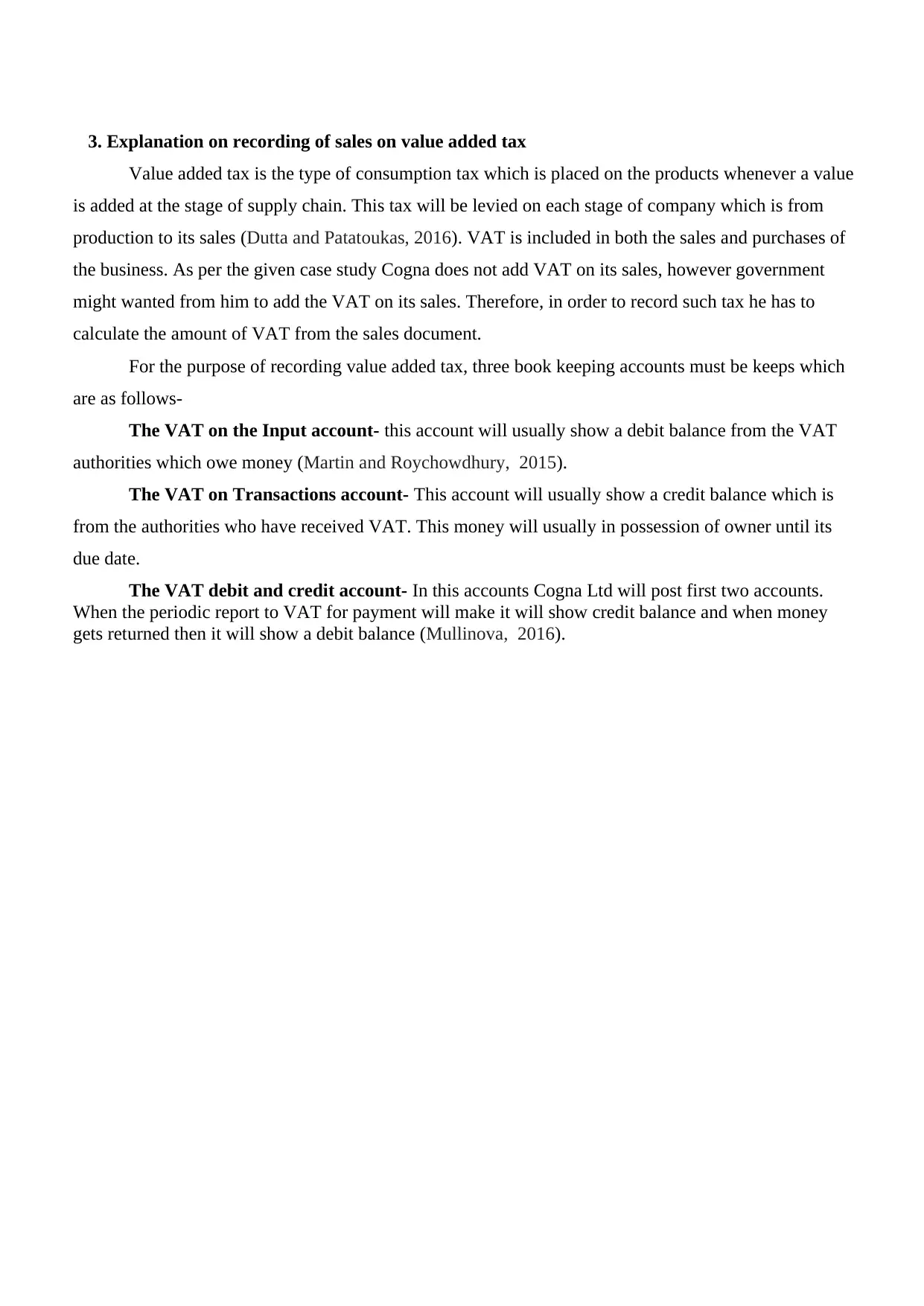
3. Explanation on recording of sales on value added tax
Value added tax is the type of consumption tax which is placed on the products whenever a value
is added at the stage of supply chain. This tax will be levied on each stage of company which is from
production to its sales (Dutta and Patatoukas, 2016). VAT is included in both the sales and purchases of
the business. As per the given case study Cogna does not add VAT on its sales, however government
might wanted from him to add the VAT on its sales. Therefore, in order to record such tax he has to
calculate the amount of VAT from the sales document.
For the purpose of recording value added tax, three book keeping accounts must be keeps which
are as follows-
The VAT on the Input account- this account will usually show a debit balance from the VAT
authorities which owe money (Martin and Roychowdhury, 2015).
The VAT on Transactions account- This account will usually show a credit balance which is
from the authorities who have received VAT. This money will usually in possession of owner until its
due date.
The VAT debit and credit account- In this accounts Cogna Ltd will post first two accounts.
When the periodic report to VAT for payment will make it will show credit balance and when money
gets returned then it will show a debit balance (Mullinova, 2016).
Value added tax is the type of consumption tax which is placed on the products whenever a value
is added at the stage of supply chain. This tax will be levied on each stage of company which is from
production to its sales (Dutta and Patatoukas, 2016). VAT is included in both the sales and purchases of
the business. As per the given case study Cogna does not add VAT on its sales, however government
might wanted from him to add the VAT on its sales. Therefore, in order to record such tax he has to
calculate the amount of VAT from the sales document.
For the purpose of recording value added tax, three book keeping accounts must be keeps which
are as follows-
The VAT on the Input account- this account will usually show a debit balance from the VAT
authorities which owe money (Martin and Roychowdhury, 2015).
The VAT on Transactions account- This account will usually show a credit balance which is
from the authorities who have received VAT. This money will usually in possession of owner until its
due date.
The VAT debit and credit account- In this accounts Cogna Ltd will post first two accounts.
When the periodic report to VAT for payment will make it will show credit balance and when money
gets returned then it will show a debit balance (Mullinova, 2016).
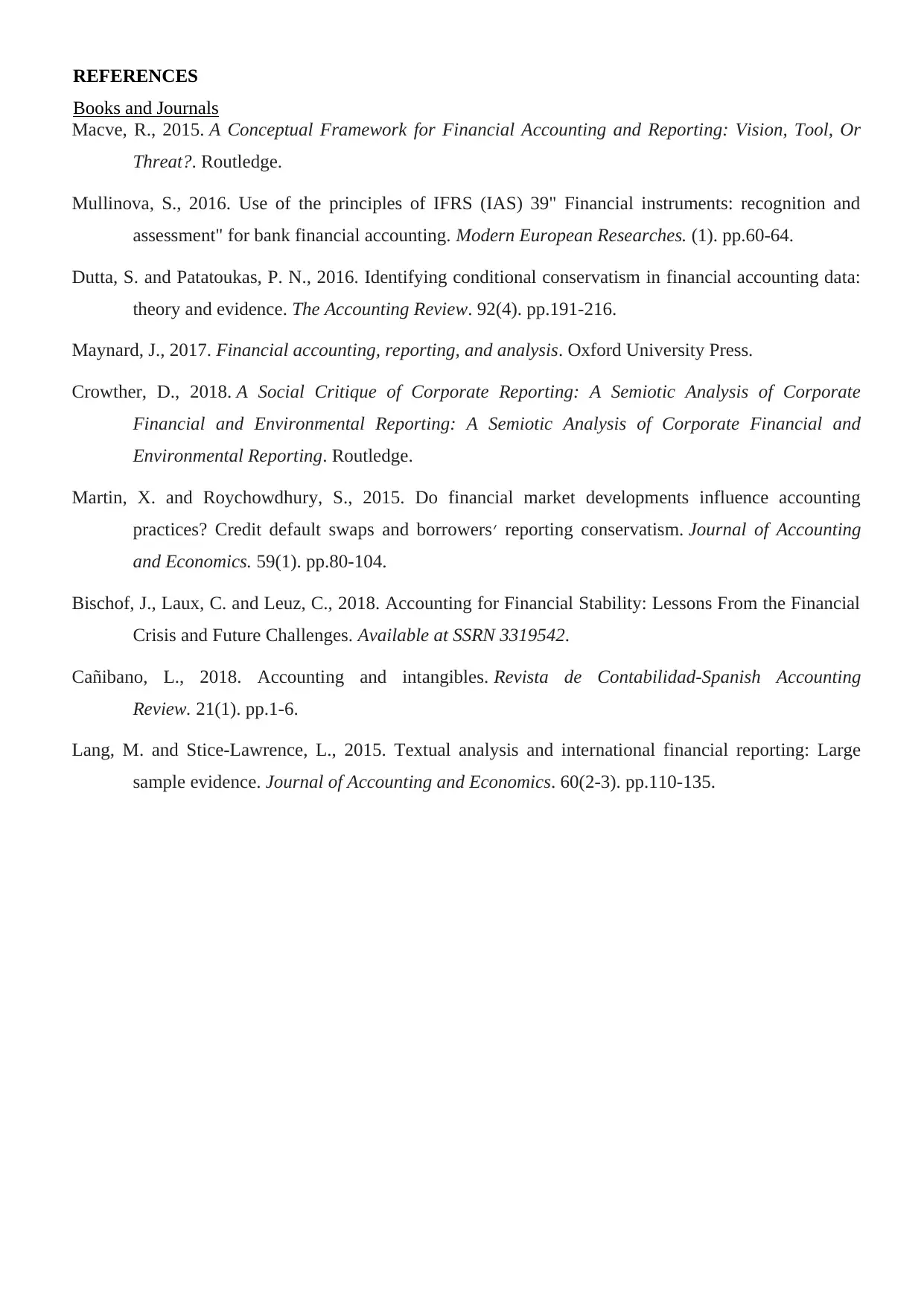
REFERENCES
Books and Journals
Macve, R., 2015. A Conceptual Framework for Financial Accounting and Reporting: Vision, Tool, Or
Threat?. Routledge.
Mullinova, S., 2016. Use of the principles of IFRS (IAS) 39" Financial instruments: recognition and
assessment" for bank financial accounting. Modern European Researches. (1). pp.60-64.
Dutta, S. and Patatoukas, P. N., 2016. Identifying conditional conservatism in financial accounting data:
theory and evidence. The Accounting Review. 92(4). pp.191-216.
Maynard, J., 2017. Financial accounting, reporting, and analysis. Oxford University Press.
Crowther, D., 2018. A Social Critique of Corporate Reporting: A Semiotic Analysis of Corporate
Financial and Environmental Reporting: A Semiotic Analysis of Corporate Financial and
Environmental Reporting. Routledge.
Martin, X. and Roychowdhury, S., 2015. Do financial market developments influence accounting
practices? Credit default swaps and borrowers׳ reporting conservatism. Journal of Accounting
and Economics. 59(1). pp.80-104.
Bischof, J., Laux, C. and Leuz, C., 2018. Accounting for Financial Stability: Lessons From the Financial
Crisis and Future Challenges. Available at SSRN 3319542.
Cañibano, L., 2018. Accounting and intangibles. Revista de Contabilidad-Spanish Accounting
Review. 21(1). pp.1-6.
Lang, M. and Stice-Lawrence, L., 2015. Textual analysis and international financial reporting: Large
sample evidence. Journal of Accounting and Economics. 60(2-3). pp.110-135.
Books and Journals
Macve, R., 2015. A Conceptual Framework for Financial Accounting and Reporting: Vision, Tool, Or
Threat?. Routledge.
Mullinova, S., 2016. Use of the principles of IFRS (IAS) 39" Financial instruments: recognition and
assessment" for bank financial accounting. Modern European Researches. (1). pp.60-64.
Dutta, S. and Patatoukas, P. N., 2016. Identifying conditional conservatism in financial accounting data:
theory and evidence. The Accounting Review. 92(4). pp.191-216.
Maynard, J., 2017. Financial accounting, reporting, and analysis. Oxford University Press.
Crowther, D., 2018. A Social Critique of Corporate Reporting: A Semiotic Analysis of Corporate
Financial and Environmental Reporting: A Semiotic Analysis of Corporate Financial and
Environmental Reporting. Routledge.
Martin, X. and Roychowdhury, S., 2015. Do financial market developments influence accounting
practices? Credit default swaps and borrowers׳ reporting conservatism. Journal of Accounting
and Economics. 59(1). pp.80-104.
Bischof, J., Laux, C. and Leuz, C., 2018. Accounting for Financial Stability: Lessons From the Financial
Crisis and Future Challenges. Available at SSRN 3319542.
Cañibano, L., 2018. Accounting and intangibles. Revista de Contabilidad-Spanish Accounting
Review. 21(1). pp.1-6.
Lang, M. and Stice-Lawrence, L., 2015. Textual analysis and international financial reporting: Large
sample evidence. Journal of Accounting and Economics. 60(2-3). pp.110-135.
1 out of 18
Related Documents
Your All-in-One AI-Powered Toolkit for Academic Success.
+13062052269
info@desklib.com
Available 24*7 on WhatsApp / Email
![[object Object]](/_next/static/media/star-bottom.7253800d.svg)
Unlock your academic potential
© 2024 | Zucol Services PVT LTD | All rights reserved.





